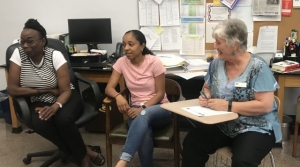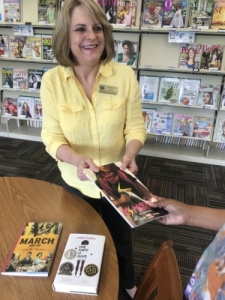Goldsboro High School, library launch racial healing program
By Phyllis Moore
Published in News on June 12, 2018 5:50 AM

News-Argus/PHYLLIS MOORE
From left, Etta Craigwell, social worker at Goldsboro High School, and Stephanie Orosco, history teacher at GHS, talk with Karen Garris, teen librarian at Wayne County Public Library, about being chosen to participate in a pilot reading program dealing with racial healing.

News-Argus/PHYLLIS MOORE
Carolyn Hill of Wayne County Public Library pulls three books that will be used as curriculum in the fall for a pilot reading program at Goldsboro High School on racial healing.
A grassroots reading program designed to open up dialogue about racial healing will be offered at Goldsboro High School in the fall.
The high school will partner with Wayne County Public Library in recruiting about a dozen interested sophomores to participate.
The library was among 25 libraries across the nation chosen for the pilot phase of the Truth, Racial Healing and Transformation Great Stories Club, an effort to engage underserved teens through literature-based library outreach programs.
Supported by a grant from the W.K. Kellogg Foundation, the goal for the national and community-based project is to bring about transformational and sustainable change, while addressing the historic and contemporary effects of racism.
Recipients of the grant represent 20 public libraries, two K-12 school libraries, one college library and two prison libraries. Each is tasked to work in partnership with either alternative schools, youth detention centers or other organizations serving youth, officials said. The libraries will work with small groups of teens to read and discuss three titles -- "Ms. Marvel Volume 1: No Normal" by G. Willow Wilson and Adrian Alphona; "The Hate U Give" by Angie Thomas; and "MARCH: Book One" by John Lewis and Andrew Aydin.
WCPL chose Goldsboro High as its partner in the effort, in part since the school is close by and also because of the potential benefits it can offer to that student population, said Karen Garris, teen librarian and project director.
Interim principal Marcia Manning readily offered support to the project, enlisting two teachers to assist -- English teacher Lahaun Watts and history teacher Stephanie Orosco. The timing is also appropriate, Manning said, since many of the stories in the national news are things that the local students are living.
"For our students, gun violence is the same and different -- it's an almost daily part of the environment for our kids," Manning said. "Many of our kids know someone who has been a victim of gun violence. For them that's different from the national conversation.
"For our kids, they understand that the typical demographic of the school shooter is very different from our student population. Our kids' perspective on the national issues are the same and different."
The average GHS student likely understands this, often from their own personal experience, Manning said, and the population makeup is obviously different from other schools in the district.
Etta Craigwell, social worker at the school, will also be part of administering the program, which features one novel and two graphic novels.
"One of the things that grabbed us about it when we heard about it was the 'racial healing,'" she said. "The first thing that I thought about is that many of our kids are not exposed to the culture, so what they are going to learn from here is they're going to learn about their own heroes and their own she-roes.
"This is going to give them the opportunity to be able to look at themselves very differently and to me, that's the healing part that is going to come about."
Orosco said what attracted her to the effort, other than the books chosen, was that they provided different perspectives about what it means to be a person of color in the United States. Diversity looks different in different areas, she said.
"I think it's going to be a good time for us to have this conversation about what it means to be a person of color here in Goldsboro, North Carolina," she said. "That's something the kids live every day, but they don't really know anything about because they're not exposed to it.
"I think the best way (to learn) is through literature. I love to read so even in my own classroom, I'm always introducing kids to different texts. I think it's going to be a good time for the kids to understand a little bit more about themselves, their culture and their history."
The organizers will develop the program over the summer, with plans to implement it when students return in the fall.
The American Library Association is making copies of the three books available to each of the 11 students chosen to participate.
The group will meet weekly, during the schoolday, and the project must be completed by Nov. 30, Garris said.
One of the culminating exercises included in the curriculum is a student-led interactive "healing circle," which organizers are especially excited to plan.
Garris said such an activity and program can easily be replicated, an idea she hopes will happen in the future.
"We'd like to continue it and actually expand it to other high schools because they all have the same problems, just different players," she said.
